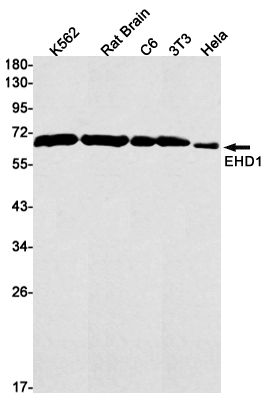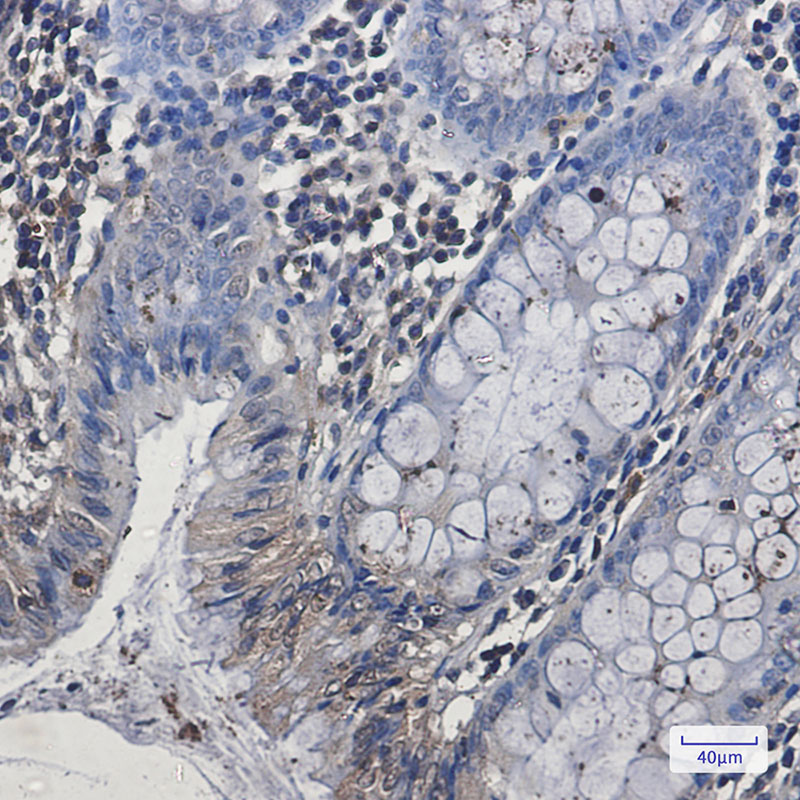


| WB | 咨询技术 | Human,Mouse,Rat |
| IF | 1/20 | Human,Mouse,Rat |
| IHC | 1/50-1/100 | Human,Mouse,Rat |
| ICC | 1/50-1/200 | Human,Mouse,Rat |
| FCM | 咨询技术 | Human,Mouse,Rat |
| Elisa | 咨询技术 | Human,Mouse,Rat |
| Aliases | EHD1; H PAST; hPAST1; PAST; PAST homolog 1; PAST1; Tilin |
| Entrez GeneID | 10938 |
| WB Predicted band size | Calculated MW: 61 kDa; Observed MW: 61 kDa |
| Host/Isotype | Rabbit IgG |
| Antibody Type | Primary antibody |
| Storage | Store at 4°C short term. Aliquot and store at -20°C long term. Avoid freeze/thaw cycles. |
| Species Reactivity | Human,Mouse,Rat |
| Immunogen | A synthetic peptide of human EHD1 |
| Formulation | Purified antibody in TBS with 0.05% sodium azide,0.05%BSA and 50% glycerol. |
+ +
以下是关于EHD1抗体的3篇参考文献及其摘要内容概括:
---
1. **文献名称**: *EHD1 regulates endocytic recycling and controls mitotic entry in mammalian cells*
**作者**: Grant BD, Caplan S (2008)
**摘要**: 该研究通过使用EHD1特异性抗体,发现EHD1蛋白通过调控细胞表面受体(如β1整合素)的内吞循环影响细胞周期进展。免疫荧光实验显示,EHD1缺失导致细胞分裂延迟,提示其在有丝分裂信号传导中的作用。
---
2. **文献名称**: *The C-terminal EH-domain of EHD1 is critical for its membrane remodeling activity*
**作者**: Daumke O, et al. (2015)
**摘要**: 作者利用EHD1抗体进行免疫印迹和共聚焦显微镜分析,发现EHD1的C端EH结构域对其在细胞膜管状结构形成中的功能至关重要,并揭示了其与衔接蛋白Rabankyrin-5的相互作用机制。
---
3. **文献名称**: *Altered expression of EHD1 in breast cancer tissues correlates with tumor progression*
**作者**: Zhang L, et al. (2020)
**摘要**: 通过免疫组化(IHC)分析乳腺癌组织样本,发现EHD1抗体标记的蛋白表达水平与肿瘤分级和转移风险显著相关,提示EHD1可能作为癌症预后的潜在生物标志物。
---
这些文献涵盖了EHD1在细胞周期调控、结构功能及疾病关联中的研究,展示了其抗体在基础机制探索和临床应用中的价值。
The EHD1 antibody is a tool used to detect Eps15 homology domain-containing protein 1 (EHD1), a member of the EHD protein family involved in membrane trafficking and endocytic recycling. EHD1. encoded by the EHD1 gene in humans, regulates intracellular transport pathways, particularly recycling receptors (e.g., β1-integrin, GLUT4) and lipids from endosomes to the plasma membrane or Golgi apparatus. It contains an EH domain for binding to proteins with asparagine-proline-phenylalanine (NPF) motifs, a coiled-coil region for oligomerization, and a C-terminal membrane-binding domain. Dysregulation of EHD1 is linked to cellular disorders, including muscular pathologies, neurodegenerative diseases, and cancer metastasis.
EHD1 antibodies are widely used in research to study trafficking mechanisms, membrane dynamics, and disease associations. They enable detection of EHD1 expression, localization (e.g., tubular endosomes), and interactions with partners like Rabenosyn-5 or MICAL-L1 via techniques such as Western blotting, immunofluorescence, and immunoprecipitation. Validating these antibodies requires attention to specificity, as cross-reactivity with other EHD paralogs (EHD2-4) may occur. Knockout models show EHD1 deficiency disrupts endosomal morphology and cargo transport, underscoring its functional importance. Commercial EHD1 antibodies are typically raised in rabbits or mice using immunogenic peptide sequences from conserved regions. Researchers prioritize antibodies verified in loss-of-function experiments to ensure reliability.
×